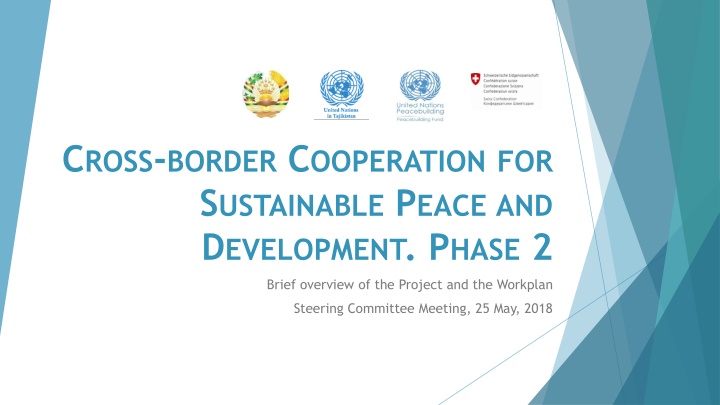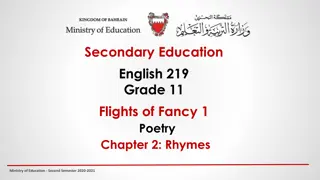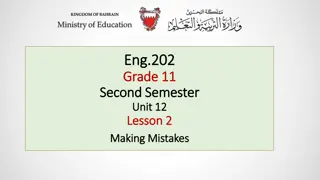
Cross-Border Cooperation for Sustainable Peace and Development Phase 2 Overview
Explore key results, lessons learned, implementers, and conflict causes of the Cross-Border Cooperation project in Tajikistan towards sustainable peace and development in this comprehensive overview.
Download Presentation

Please find below an Image/Link to download the presentation.
The content on the website is provided AS IS for your information and personal use only. It may not be sold, licensed, or shared on other websites without obtaining consent from the author. If you encounter any issues during the download, it is possible that the publisher has removed the file from their server.
You are allowed to download the files provided on this website for personal or commercial use, subject to the condition that they are used lawfully. All files are the property of their respective owners.
The content on the website is provided AS IS for your information and personal use only. It may not be sold, licensed, or shared on other websites without obtaining consent from the author.
E N D
Presentation Transcript
CROSS-BORDER COOPERATION FOR SUSTAINABLE PEACE AND DEVELOPMENT. PHASE 2 Brief overview of the Project and the Workplan Steering Committee Meeting, 25 May, 2018
Key results of the first phase in Tajikistan* TRACTION is operational 80 events (meetings, trainings, consultations etc.) were implemented by security providers, local authorities and communities on one side of the border 11 events jointly implemented involving security providers, local authorities and communities from both sides of the border 2 complaints mechanisms supported (Office of Ombudsperson, Regular meetings of the representatives of Border Services of RT with the local population) 31 community projects implemented 3,423 young people participated in cross-border events 1,601 young people participated in in-country events 7 women business initiatives supported *Data reflect results achieved using resources provided by both donors
Lessons learnt Relevance and effectiveness of the project and activities reconfirmed; Strong national ownership in Tajikistan emphasized; Strong linkage to conflict risk analysis (TRACTION) and conflict sensitivity is backbone principle of the project; Institutionalization options; Previous phase from Outputs to Activities; Need for Strategies; Inception phase recommended to discuss linkages and synergies between Agencies; Integrated Strategies and Activities; Need for more in-depth technical review of projects by each side, SOPs; Root causes (e.g. lack of demarcation) require additional consultations and framing activities Recommendations to support interest-based (economic) linkages between people
Key information Implementers: 5 Agencies - FAO, UNDP, UNICEF, UN Women, WFP; using mandate and competitive advantages of UN Agencies in the country Implemented by UN teams in Tajikistan and Kyrgyzstan Duration: 18 months [13 April 2018 13 October 2019] Budget: USD 1 million (with the same amount on KG side) Donor: UN Peacebuilding Fund, Swiss Development Cooperation (the first phase in Tajikistan continues till June 2018)
Overview of conflict causes and problems ROOT CAUSES Incomplete delimitation and demarcation Infrastructure built during Soviet period without regard to national borders Stricter border regimes and enforcement Demographic pressures PROBLEMS: Increased land scarcity and increased stress on water resources Disagreements over the use of natural resources No confidence-building mechanisms to solve emerging issues at local level CONSEQUENCES: Communal clashes and incidents leading to intolerance, misunderstanding, with the risk of escalation
Conflict dynamics - I Number of incidents and trend, January 2015-December 2017, TRACTION data 9 9 8 7 7 7 6 6 5 5 5 4 4 4 3 3 3 3 3 3 2 2 2 2 2 2 2 2 2 1 1 1 0 0 0 0
Conflict dynamics II Conflict incidents yearly trends, January 2015-December 2017, TRACTION data 9 9 8 7 7 7 6 6 5 5 5 5 4 4 3 3 3 3 3 3 2 2 2 2 2 2 2 2 2 1 1 1 0 0 0 0 JANUARY FEBRUARY MARCH APRIL MAY JUNE JULY AUGUST SEPTEMBER OCTOBER NOVEMBER DECEMBER 2015 2016 2017
Conflict dynamics - III Types of conflict incidents, January 2015-December 2017, TRACTION data 52 19 17 10 10 8 7 1 1 1 0
Conflict dynamics - IV Geographical locations of incidents (2015-2017), TRACTION 70 63 60 49 50 40 Number of incidents 30 20 18 20 13 9 10 7 0 Chorkuh - Koktash Vorukh Aksay Ovchikalacha - Kulundu Histevarz - Janyjer Lakkon - Karabak Surkh - Pasky Aryk Other
Project goals To build sustainable mechanism to reduce the risks of violent conflict and to create a more conducive environment for the promotion of sustainable peace and development in cross-border areas. Outcome 1: Cooperation and trust between communities increased to mitigate risks of renewed violence Output 1. Improved linkages and cooperation between security providers, local authorities and communities to reduce violent incidents Output 2: Communities restore cross-border linkages and trust by jointly addressing interdependent needs/ challenges associated with community infrastructure and natural resources, as well as by establishing platforms of confidence-building and cooperation between various societal groups
Selected principles of project implementation Conflict sensitivity and do no harm approach; National ownership Infrastructure ( hard ) and capacity building ( soft ) interventions; Tailoring mandates of Agencies Mirroring (but with contextualization of interventions) Linking dialogue platforms to the resolution of concrete needs of communities; Maintaining flexibility of the project to changing situation on the ground; Bottom-up approach, keeping interventions at community level, promoting dialogue and joint problem solving
Workplan Basic principles of design Fully corresponds to the Project Document and meets all commitments taken before the donor Agreement of all partners in the country (UN and the Government); consultation process Harmonization with Kyrgyzstan (in key categories, the plan is similar, changes are possible at the implementation level contextualization Approved by the Steering Committee Can be revised based on additional analysis and joint consultations with the Government of the Republic of Tajikistan
Workplan Output 1. Cooperation to mitigate/prevent grievances over border crossing Strategy 1.1. Raise awareness of population on cross-border crossing rules Activity 1.1.1. Support law enforcement services to adapt information materials to reflect context of the target area (ensure gender sensitivity where necessary) Activity 1.1.2. Raise awareness of adolescents, parents and teachers on cross-border rules and child rights in cross-border schools Activity 1.1.3. Support and cooperation with the existing platforms at the national/ regional /or district level on addressing the concerns of women, men, girls and boys related to the border Activity 1.1.4. Support of local initiatives on improving cooperation with the local authorities and law enforcement structures (ensure, among others, gender responsiveness).
Workplan Output 1. Cooperation to mitigate/prevent grievances over border crossing Strategy 1.2. To improve the complaints mechanism through cooperation with the Ombudsman Office and other relevant institutions Activity 1.2.1. Organize community meetings with Ombudsman, law enforcement structures and authorities to ensure access of communities to the complaint mechanism (Ombudsman). Raise awareness of the communities on complaint mechanisms, including child rights. Empower women leaders to participate in community meetings. Activity 1.2.2. Follow up meetings/action of Office of Ombudsman with the local government and respective state structures at district, regional and national level (to raise complaints and ensure that they are addressed) /Capacity building of the Ombudsman for Child Rights to strengthen complaint mechanisms at district and national level Activity 1.2.3. Improving cooperation between Ombudsman Offices of RT and KR
Workplan Output 1. Cooperation to mitigate/prevent grievances over border crossing Strategy 1.3. Build capacity of law enforcement agencies on human rights and build linkages between citizens and duty bearers Activity 1.3.1 Elaborate the cooperation plan with the Border Service and Police on strengthening the linkages between the law enforcement structures, local government and citizens (women, men, girls and boys) (and its further implementation) Activity 1.3.2. Ensure that concerns raised during community meetings are discussed during meetings of border guards of both countries and follow up actions are taken. Ensure gender balanced approach where necessary. Activity 1.3.3. Capacity building events (or consultation meetings) provided by Ombudsman office for border guards and other law enforcement services. Capacity building will integrate human rights and gender perspectives
Output2. Cross-border linkages and trust through joint projects and confidence building platforms Strategy 2.1. Facilitate dialogues within and between communities as well as participatory decision-making process through implementation of community initiatives Activity 2.1.1. Carry out contextualized in-depth joint situation assessment (review of legal framework, conflict sensitivity, gender and environmental risks, identifying geographical areas which require more attention, potential contentious issues, understanding local power dynamics in specific municipalities) - through the mechanisms of community dialogue and consultations, consultations with authorities and other channels, as per SOPs. Activity 2.1.2. Carry out Community Dialogue - joint participatory planning of priorities (risk- informed), to ensure inclusion of vulnerable groups (women, youth etc.) Activity 2.1.3 Support of operation of various consultative platforms at jamoat Activity 2.1.4. Rehabilitation or building (through a community-led and inclusive approach) small- scale social or natural resource-related infrastructure with a high potential for reducing tensions. Streamline UN agencies joint approach in implementation of community projects.
Output2. Cross-border linkages and trust through joint projects and confidence building platforms Strategy 2.2. Enhance cooperation in natural resource management and increase the effectiveness and transparency of the use of the natural resources to reduce the likelihood of the conflict Activity 2.2.1. In-depth analysis of pasture management and pasture-related conflict sensitivity as well as water management issues Based on results of the In-depth Analysis the following Activities will be considered for implementation and detailed Action Plan will be developed. Activity 2.2.2. Build awareness and promote dialogue of stakeholders and communities on pasture management issues and water management issues (with ensuring participation of women). Undertake advocacy actions at local and national levels. Activity 2.2.3. Build capacities of communities in pasture management and water management in WUAs (with ensuring empowerment of women). Activity 2.2.4. Provide contextualized capacity building on water resources management for WUAs (supporting implementation of infrastructure projects under Strategy 1). Irrigation related constructions (Water distribution, water measuring facilities, drip irrigation systems and trainings, with balanced representation of men and women). Activity 2.2.5. Facilitate cross-country communication and cooperation (including field visits) between WUAs of Tajikistan and Kyrgyzstan
Output2. Cross-border linkages and trust through joint projects and confidence building platforms Strategy 2.3. Enhance cross-border linkages between communities, especially women and youth through the support of the confidence building platforms Activity 2.3.1. Carry out 3-level consultation process (jointly UNICEF and UNDP) - 1) in- country focus groups, 2) consultations between countries 3) discussion at wider community meetings (Activity 2.1.3) to identify priorities of adolescents and youth initiatives Activity 2.3.2. Enhance cross-border linkages between adolescents, youth and community through joint cultural and time-extended initiatives/exchanges through Youth Contact Groups (UNDP), schools, student councils and local level dialogue platform (with authorities); including interest-based cross-border trainings for trust building. Activity 2.3.3. Support tolerance building initiatives by adolescents and youth, including across the border with small grants that aim to promote cross-border linkages
Output2. Cross-border linkages and trust through joint projects and confidence building platforms Strategy 2.4. Enhance peacebuilding skills of beneficiaries within countries (focus on youth and women) Activity 2.4.1.Build capacities of women leaders - through in-country and cross-border events - on conflict analysis, mediation, natural resource management and ensure their contribution to conflict assessment and monitoring mechanisms, dialogue and consultation meetings; Activity 2.4.2. Developing peacebuilding competencies of adolescents Activity 2.4.3. Outreach services are in place for adolescents to have access to youth-friendly psychological support and care Activity 2.4.4 Advocate for adherence to minimum standards of gender equality and women empowerment in decision-making processes, community dialogues, conflict/disputes resolution. Ensure exchange of women at the events. Activity 2.4.5 Capacitate women leaders on NAP 1325 to identify issues and good practices of women-led conflict resolution to feed into NAP 1325 and participate in consultative meetings for development of new UNSCR 1325 NAP Activity 2.4.6 Support establishing the associations of women peacebuilders in Sughd region jointly with the National Committee for Women s and Family Affairs that will include women leaders
Output2. Cross-border linkages and trust through joint projects and confidence building platforms Strategy 2.5. Promote economic ties between cross-border communities and harness employment-related activities to build bridges between people, especially youth and women Activity 2.5.1 Build capacities of youth and women on business skills/entrepreneurship such as business planning, income generating activities Activity 2.5.2. Support women business initiatives that build linkages between women of Tajikistan and Kyrgyzstan Activity 2.5.3. Establish linkages between business associations of both countries (youth focused) and improve trade through supporting market linkages (support innovation for cross border business) in local markets. Innovations for cross-border business Activity 2.5.4. Supporting vocational skills and agricultural processing through activities related to employment and ties building for youth and women from conflict prone areas. Vocational training activities will be linked to actual business (theme related to agriculture, processing, handcraft) opportunities which help maintaining durable ties between neighbor communities. It will be followed up with joint events with participation of Kyrgyz and Tajik youth and women on increasing trust and tolerance by building up relations and solidarities. Activity 2.5.5. Professional orientation and building social entrepreneurship skills among youth and adolescents
Funding distribution per Strategies , 8% 1.1. 4% 1.2. 7% 2.5 7% 1.3 4% 2.4. 14% 2.1. 35% 2.3. 11% 2.2. 10%
Operational targets: Output 2 At least 10 interventions/ activities/ preventive actions that were implemented by security providers, local authorities and communities of Tajikistan on one side of the border (20 for both sides) At least 4 interventions/ activities/ preventive actions that were jointly (cross-border, with participation of Tajikistan and Kyrgyzstan participants) implemented involving security providers, local authorities and communities Maintain and improve 2 existing problem solving and complaints mechanisms in the Republic of Tajikistan (4 for both sides) * Targets presented will be achieved from UN PBF funding only. After SDC funding is approved targets will be revised (increased)
Operational targets: Output 2 At least 10 projects in the Republic of Tajikistan that were jointly agreed and implemented by communities from both sides (20 for both countries). At least 500 adolescents and young people from Tajikistan participated in cross-border joint youth event (1000 for both countries) 400 adolescents and young people from Tajikistan participated in in-country youth events that aim to promote inter-ethnic tolerance in pilot cross-border village clusters (800 for both countries) At least 4 cross-border women s initiatives (small projects) implemented by women * Targets presented will be achieved from UN PBF funding only. After SDC funding is approved targets will be revised (increased)





















